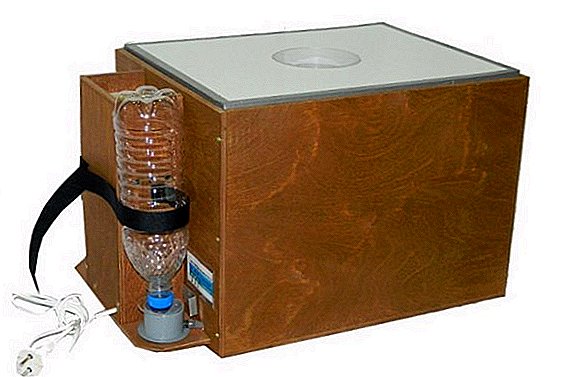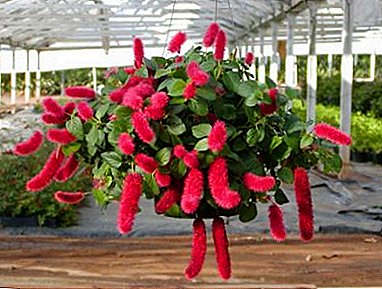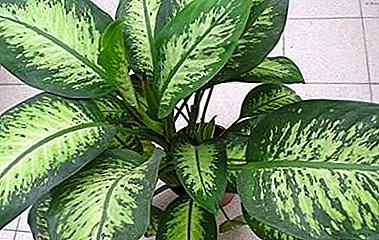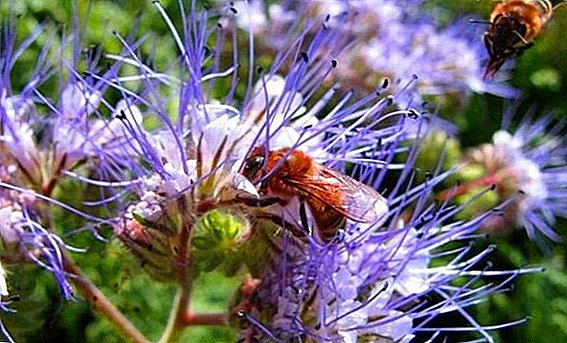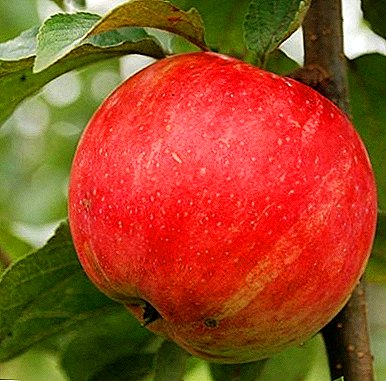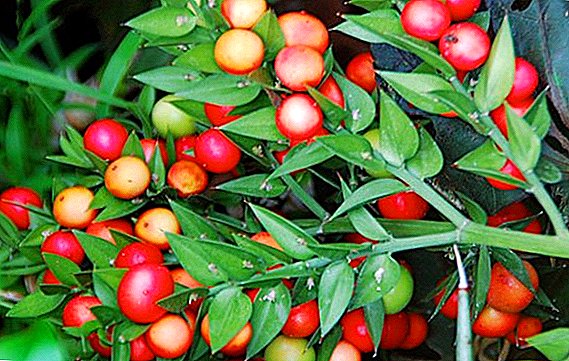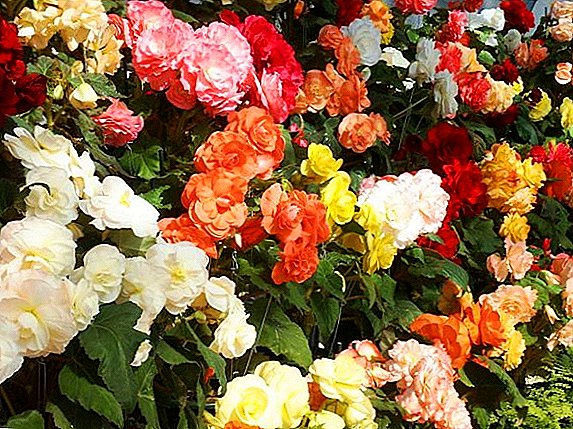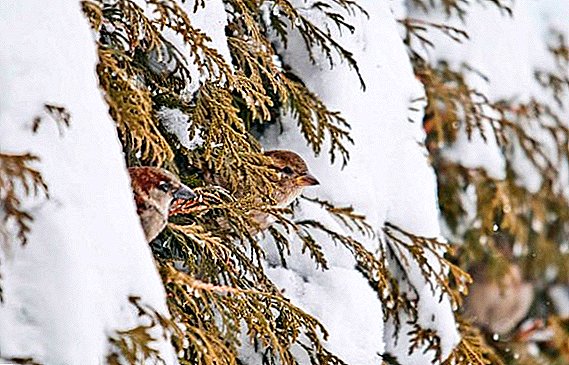 The thuja is an evergreen coniferous plant, the representative of family of Cypress, which was widely adopted in landscape and landscape design. This plant retains its lush greenery all year round and is quite resistant to cold. However, it requires additional care and care in the early years of planting, especially in the matter of preparing for the winter period. In this regard, let us see whether it is necessary to protect the thuja from the effects of low temperatures, and how to do it correctly.
The thuja is an evergreen coniferous plant, the representative of family of Cypress, which was widely adopted in landscape and landscape design. This plant retains its lush greenery all year round and is quite resistant to cold. However, it requires additional care and care in the early years of planting, especially in the matter of preparing for the winter period. In this regard, let us see whether it is necessary to protect the thuja from the effects of low temperatures, and how to do it correctly.
Should I cover
If you ask this question to experienced gardeners, you can sometimes hear that thuja does not need additional shelter. However, such advice may be negatively displayed on your conifer scenery. Let's take a closer look at this issue.
Young plants and thuja, transplanted into open ground, are especially in need of shelter for rest, as they are most vulnerable in winter. They are adversely affected by not only low temperatures and cold wind, but also exposure to sunlight, fertilizers, pests and insufficient soil moisture.  Although thuja is a fairly cold-resistant plant that can safely transfer frost to -35 ° C, however, the crowns in some species under the influence of cold can change their color to bronze. You should not worry too much about this, since with the onset of warm spring days they will again become their natural color. When buying a thuja, you need to get advice from a competent specialist. This is due to the fact that different types have different frost resistance.
Although thuja is a fairly cold-resistant plant that can safely transfer frost to -35 ° C, however, the crowns in some species under the influence of cold can change their color to bronze. You should not worry too much about this, since with the onset of warm spring days they will again become their natural color. When buying a thuja, you need to get advice from a competent specialist. This is due to the fact that different types have different frost resistance.
With insufficient watering the crown of the tree begins to dry and grow brown. In the autumn, when there is not enough rainfall, thuyu must be watered abundantly, which will allow it to stock up on liquid for the winter period. However, overdoing is also not worth it, because excessive soil moisture can cause root rot.
Abundant fertilizer Tui will cause the rapid growth of the plant, because of which later it will be necessary to devote more time to the formation of the external form and pruning the plant. Optimal mineral and organic make-up twice a year.
Learn how to plant thuya cuttings and seeds, which are dangerous diseases and pests of tui.Like other plants, thuja is exposed to various pests and diseases. If you do not conduct a regular inspection of the plant, the disease will begin to progress, and coniferous vegetation will become unusable. When it detects stains or plaque on a thuja, it is treated with various drugs, the choice of which depends on the type of diseases or pests. As a preventive treatment, thuja is sprayed with Bordeaux liquid.

Important! If a hedge is severely affected by phytophtora, it is recommended to remove not only it, but also the soil in which it grew. Such measures are related to the fact that this fungal disease is able to live in the soil for a long time.Acidity and alkaline composition of the soil can affect the survival and growth of needles. The best soil for growing thuja is a soil with a low content of alkalis and acids. If in the process of growing your plant begins to turn yellow, you should check these figures and, if necessary, to take measures to stabilize them.
Learn how to independently determine the acidity of the soil in the area, how to deoxidize the soil.During the period of active growth, the thuy is recommended to be protected from exposure to sunlight, which can cause burns. Most often, this problem occurs in early spring, when the sun warms the plant, and a sufficient amount of moisture does not flow.
When the warm sunshine in the early spring warms up the air sufficiently, the thuja goes into an active stage of growth. However, the lack of moisture can lead to a change in the color gamut of the plant, and further - to its drying out and abscission. In this case, it is recommended to cover with sacking or to pretreat it with special preparations.  The urine of animals is another negative factor that can lead to the death of coniferous hedges. Urine leads to blackening of the needles, then it dies off. To protect the thuja from the negative impact of animals, it is recommended to remove the damaged needles, and protect the plant from pets.
The urine of animals is another negative factor that can lead to the death of coniferous hedges. Urine leads to blackening of the needles, then it dies off. To protect the thuja from the negative impact of animals, it is recommended to remove the damaged needles, and protect the plant from pets.
Find out what are the distinguishing features of Tui Brabant, Columna, Danica, Smaragd.
When to cover
For the preservation of the beauty of decorative plantations need to make careful preparation for their wintering. It is necessary to begin preparing thuja for rest from the beginning of August, when any plant feeding is stopped. If this is not done, then the needles will continue to grow actively, and the branches will not be sufficiently strengthened by the onset of frost.
Before sheltering a tree, it is recommended to prune and form a crown, and in the beginning of autumn to produce a one-time abundant watering with the addition of root-forming preparations, which will strengthen the root system. Young plants especially need such watering. However, do not be zealous, as excessive watering can lead to rotting or freezing of the roots.  Experienced gardeners recommend covering thuja at the end of autumn, when cloudy weather without precipitation persists, and the air temperature does not fall below +4 ° C. If you prepare the plant for rest without observing this rule, then there is a possibility that the winter for your beauty will be a difficult test of endurance.
Experienced gardeners recommend covering thuja at the end of autumn, when cloudy weather without precipitation persists, and the air temperature does not fall below +4 ° C. If you prepare the plant for rest without observing this rule, then there is a possibility that the winter for your beauty will be a difficult test of endurance.
Before preparing the thuja for rest, it is necessary to clean the crown of faded needles and to make a planned treatment of the coniferous tree from fungal diseases and pests. Such processing is carried out in two stages, which will protect the plant.
Important! Fallen pine needles must be completely removed, since fungal diseases or pests can remain on it.
Root protection
The cypress root system is superficial, therefore, like the crown of the plant, it requires protection, especially in dry and frosty winters. It is necessary to begin the weatherization of the roots by harvesting all the weeds that grow around the crown.
For the best wintering in August, autumn fertilizer with a high content of potassium and phosphorus is scattered around the tree circle. And the thuja root zone is very carefully dug up, as its roots are located close to the soil surface. Such processing of the root system will allow the plant to safely endure the winter cold and awaken in the spring.  The use of granular fertilizer is very convenient, since it dissolves when moisture enters. If you water the thuja yourself, then you need to control the degree of soil moisture. To check the soil for moisture content, simply take a small lump of earth and try to squeeze it. If, after opening the palm, the soil has a crumbly shape, then the plant needs additional hydration.
The use of granular fertilizer is very convenient, since it dissolves when moisture enters. If you water the thuja yourself, then you need to control the degree of soil moisture. To check the soil for moisture content, simply take a small lump of earth and try to squeeze it. If, after opening the palm, the soil has a crumbly shape, then the plant needs additional hydration.
Important! It is necessary to approach the question of fertilizer very carefully, since excessive fertilizer of thuja will be a signal for active growth.However, such measures for the good protection of the root system are not enough, as there is a danger of soil freezing and, accordingly, drying of the roots. In order to avoid such an impact, at the end of October, we produce a wooded circle. This can be done using coniferous land, dung, straw, peat, compost or foliage of forest trees. This mulch allows you to retain moisture in the soil and protect the root system from the cold, especially young plants. It is filled with a loose layer around the trunk of a thuja with a height of 10-30 cm, depending on the decrease in temperature in winter.
Additionally, you can protect the roots with the help of branches of evergreen trees, the so-called spruce branches. This coating is placed on top of the loose layer of mulch, and in the spring it is removed, the mulch mixture is left, as it is a natural fertilizer for thuja.
Find out what they use mulching, how to apply peat, compost, sawdust, straw on the site.
Plant protection
Throne croon during rest is exposed to low temperatures, bright sunshine and heavy snow cover. In this regard, weak and immature conifers need additional protection and shelter for the winter period.
Cover materials and features of their use
If you have a small thuja growing, you can use available tools, such as a plastic bottle, to cover it. However, for plants of large sizes this option is not suitable, and here it is important to determine which materials can be used, their advantages and disadvantages.
Before hiding a thuja, it is necessary to protect the crown from falling apart, especially if the plant consists of several trunks or has a spherical shape. To do this, use a rope of natural fibers. She tied the lower part of the trunk and gradually spiral movements wrapped around the entire crown of a coniferous plant. This way you can strengthen the crown of both small plants and large ones. If a high thuja fails to tie up completely, then you can do it to the height of your height.
Cover the crown with:
- nonwoven materials, for example, agrofibre, lutrasil, spunbond, agrospan;
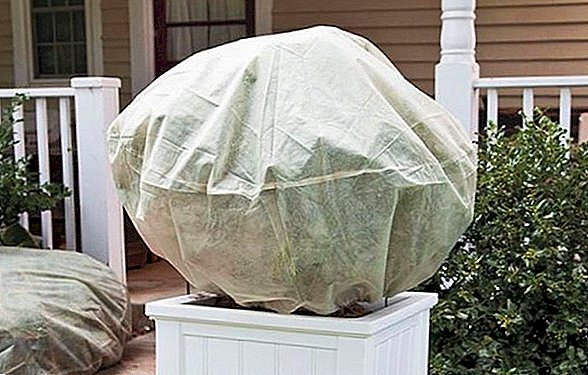
- gauze;

- burlap;

- kraft paper.

The choice of non-woven material must be approached very seriously. The material must be chosen sufficiently thin in order for the plant to breathe well, therefore, polyethylene is not used for sheltering tui. With the help of a stapler, bag-shaped covers are formed from the material according to the size and shape of the plant. Modern manufacturers have already solved the problem of the formation of such covers, so there is a large assortment of shelters for Tui made from such materials.
Important! It is necessary to use nonwovens to cover the thuja with caution, because on warm winter days they do not allow air to pass through, causing condensation to accumulate and the plant to rot.Gauze and burlap, unlike agrofibre and their analogs, are well breathable and do not collect condensate. Sacking is convenient for covering the thuja by the fact that it is a natural material, and with its help it is possible to form a cover similar to that of a nonwoven fabric. However, when using gauze to stretch such a shelter, it is not worth it, since it may settle with precipitation.
 Shelter thuya gauze must be made in several layers. Before starting work, it is recommended to cut strips corresponding to the height of the tree. Shelter begin to cover the top and gradually descend to the base of the crown. For better protection, the plant is closed in several layers, and combine them with a stapler. All work must be done very carefully, as it is likely to damage the plant.
Shelter thuya gauze must be made in several layers. Before starting work, it is recommended to cut strips corresponding to the height of the tree. Shelter begin to cover the top and gradually descend to the base of the crown. For better protection, the plant is closed in several layers, and combine them with a stapler. All work must be done very carefully, as it is likely to damage the plant.Another material to protect the crown can be kraft paper. Wrap the crown begin to top and spiral down to the base. Such material must be laid overlapped, and fixing is carried out using a stapler and rope.
Did you know? American scientists have developed a drug "Purshate"which when sprayed over the thuja forms a protective film. This film reflects the negative radiation of sunlight.
Frame
For insulation of young plants using frame structures. You can make them yourself or purchase ready-made options. Forming a frame support at home will require thick slats, bars, thin plastic tubes, wires and metal corners.  For tui of small size, constructions from three pillars are used, for larger plants and with a spreading crown, constructions on 4 pillars are used. The length of the frame leg should be at least 2/3 of the height of the thuja, and for better fixation they are hammered into the ground to a depth of 20 cm. If there is enough material, you can make a design taking into account the grip of the crown. For fixing the material using cross and connecting racks.
For tui of small size, constructions from three pillars are used, for larger plants and with a spreading crown, constructions on 4 pillars are used. The length of the frame leg should be at least 2/3 of the height of the thuja, and for better fixation they are hammered into the ground to a depth of 20 cm. If there is enough material, you can make a design taking into account the grip of the crown. For fixing the material using cross and connecting racks.
On the frame they put a cover made of protective material, for example, a cover made of agrofibre. It is stretched onto the frame, and the fasteners are fixed to the horizontal bars and the bases of the struts.
Learn how to cover roses, grapes, apples for the winter.The use of this design has one significant drawback: in a snowy winter, it is necessary to regularly clean snowdrifts. The most common design in the form of a hut, but it requires the shelter of the entire plant.
When using a spherical structure made of thin pipes, the upper part is fixed with a twine, wire, or cross connection (for a metal pipe construction). This form of the frame contributes to the rolling of snowdrifts.  With a lack of time to create the frame, in stores specialized purpose, you can buy ready-made designs. There you can choose the frame of the desired shape and from any material. The skeleton design allows you to protect the plant not only from the loss of a large amount of precipitation, but also well protects the roots from freezing.
With a lack of time to create the frame, in stores specialized purpose, you can buy ready-made designs. There you can choose the frame of the desired shape and from any material. The skeleton design allows you to protect the plant not only from the loss of a large amount of precipitation, but also well protects the roots from freezing.
Learn, than the thuja is useful, how to grow up thuja in the room.
Proper care in winter
The job of caring for thuja is not limited only to her shelter during the rest. With the onset of cold weather and heavy precipitation, work is just beginning. After heavy snowfall, the thuja needs to be given due attention, otherwise its crown may squint under the influence of snow. The tree must be freed from accumulated snow cover.
In early spring, when winter has only receded, you should not hurry and take shelter, as the needles can suffer from sunburn. Experienced gardeners recommend removing protection only after the weather has stabilized.
Grow thuyu is not as easy as it seems at first glance. The plant requires special attention in the early years, when it especially needs shelter and protection for the winter period. However, by performing simple activities, you can save the pine beauty, which for a long time will be a great decoration for your site.
Video: what can be if you don’t cover the Tui
Shelter Tui for the winter: reviews

But the juniper now burned at me and not weakly. So I’m sure to cover him and, perhaps, pour some warm water when a light plus is established. I think it is necessary to water it at the moment when there are already pluses, but the earth is still not thawed out inside, but it has thawed 5-10 cm.









